| . |
| . |
| . |
| . |
| . |
| . |
| . |
| . |
| . |
| . |
PROBLEM:
Corrosion holes on 20% of
tubing
CAUSE:
Corrosion inhibitor worn off
by rod string ( boxes, guides,
or body)
REMEDY (tubing corrosion):
1) Manual tubing rotator
2) Polyethylene-lined tubing
REMEDY (rod corrosion):
1) Rod rotators
2) Spray metal alloy boxes
Corrosion holes on 20% of
tubing
CAUSE:
Corrosion inhibitor worn off
by rod string ( boxes, guides,
or body)
REMEDY (tubing corrosion):
1) Manual tubing rotator
2) Polyethylene-lined tubing
REMEDY (rod corrosion):
1) Rod rotators
2) Spray metal alloy boxes
1) OXYGEN
Large, shallow, flat bottomed pitting with pit edges gradually sloping
and running into each other
2) HYDROGEN SULFIDE
Pits small and cone shaped with steep sloping sides and round
edges on metal surfaces. Generally pits are not connected and may
contain wide, sharp fatigue cracks. Surface may have iron sulfide
scale (black, sticky, and rotten egg odor.
3) CARBON DIOXIDE
Round-bottomed pitting with sharp sides and normally connected
with other pits. Surface may have iron carbonate scale (gray).
Large, shallow, flat bottomed pitting with pit edges gradually sloping
and running into each other
2) HYDROGEN SULFIDE
Pits small and cone shaped with steep sloping sides and round
edges on metal surfaces. Generally pits are not connected and may
contain wide, sharp fatigue cracks. Surface may have iron sulfide
scale (black, sticky, and rotten egg odor.
3) CARBON DIOXIDE
Round-bottomed pitting with sharp sides and normally connected
with other pits. Surface may have iron carbonate scale (gray).
| PROBLEM: External corrosion CAUSE: Tubing wear against casing, wiping off inhibitors REMEDY: 1) Tubing anchor 2) Manual tubing rotator |
Note: casing vent lines, rubber packing, etc. can help stop oxygen entry
PROBLEM:
Corrosion pitting around entire circumference of tubing or rods
CAUSE:
Poor corrosion inhibitor film (if any)
REMEDY:
1) Change chemical program (type, frequency, circulation time)
2) Minimize elements (oxygen, bacteria, etc.)
3) Fiberglass tubing/rods
4) Manual tubing rotator w/ chemical
Corrosion pitting around entire circumference of tubing or rods
CAUSE:
Poor corrosion inhibitor film (if any)
REMEDY:
1) Change chemical program (type, frequency, circulation time)
2) Minimize elements (oxygen, bacteria, etc.)
3) Fiberglass tubing/rods
4) Manual tubing rotator w/ chemical
PROBLEM:
Tubing plits
CAUSE:
Rod wear against tubing
REMEDY:
1) Tubing Rotator
2) Polyethylene-lined tubing
3) Rod guides
4) Slow SPM
5) Sinker bars if wear near
bottom
Tubing plits
CAUSE:
Rod wear against tubing
REMEDY:
1) Tubing Rotator
2) Polyethylene-lined tubing
3) Rod guides
4) Slow SPM
5) Sinker bars if wear near
bottom
| COMMON CORROSION TYPES |
| Rod Pumping Failure Analysis |
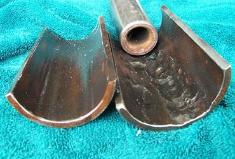
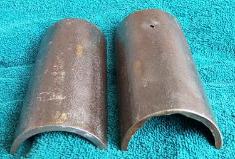
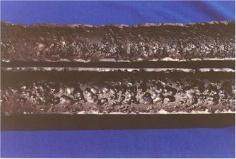
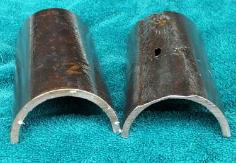
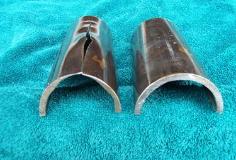
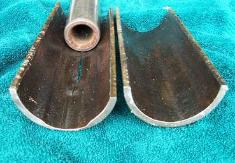
| . |
| . |
| . |
| . |
| . |
| . |
PROBLEM:
Rod box or body failures due to corrosion around
all of the tubing circumference
CAUSE:
Inadequate or no corrosion inhibition program
REMEDY:
1) Spray metal alloy rod boxes for box failures
2) Improve or implement chemical program (type,
frequency, circulation time) for boxes and bodies
Rod box or body failures due to corrosion around
all of the tubing circumference
CAUSE:
Inadequate or no corrosion inhibition program
REMEDY:
1) Spray metal alloy rod boxes for box failures
2) Improve or implement chemical program (type,
frequency, circulation time) for boxes and bodies
PROBLEM:
Pin breaks due to
make-up
CAUSE:
Over-tightened or
under-tightened connections
REMEDY:
Proper Make-up
Pin breaks due to
make-up
CAUSE:
Over-tightened or
under-tightened connections
REMEDY:
Proper Make-up
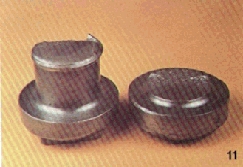
PROBLEM:
Rod Body Failures due to fatigue
CAUSE:
Tension or compression failures as indicated by horizontal lines on the rod body
Note: compression usually has cracks on one side, while tension usually has lines
around the entire circumference
REMEDY:
1) Redesign to reduce rod stresses (SPM, pump size, sinker bars, stroke length, etc.
2) Wheeled rod guides reduce friction on up and down stroke (helps tension &
compression)
3) Remove some rod guides that may be increasing stress on rods
Rod Body Failures due to fatigue
CAUSE:
Tension or compression failures as indicated by horizontal lines on the rod body
Note: compression usually has cracks on one side, while tension usually has lines
around the entire circumference
REMEDY:
1) Redesign to reduce rod stresses (SPM, pump size, sinker bars, stroke length, etc.
2) Wheeled rod guides reduce friction on up and down stroke (helps tension &
compression)
3) Remove some rod guides that may be increasing stress on rods
| . |
| . |
| . |
| . |
PROBLEM:
Worn pumps
CAUSE:
Wear over time or solid abrasions (sand, scale or pump
chrome after acid jobs)
REMEDY:
1) Mud anchors
2) Raise pump depth
3) change pump type
4) tubing rotation should spread wear/abrasion around pump
to extend life
5) Gravel packs, etc.
Worn pumps
CAUSE:
Wear over time or solid abrasions (sand, scale or pump
chrome after acid jobs)
REMEDY:
1) Mud anchors
2) Raise pump depth
3) change pump type
4) tubing rotation should spread wear/abrasion around pump
to extend life
5) Gravel packs, etc.
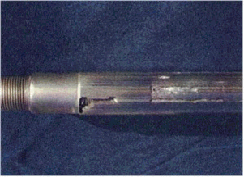
PROBLEM:
Rod box or rod body failures due to wear
CAUSE:
Wear or "corrosion due to wear wiping
off corrosion inhibitor" on one side of the
rod box or rod body
SOLUTION:
(1) Spray metal alloy rod boxes for wear
(2) rod rotator for box or rod body wear
(3) rod guides
(4) continuous rods
Rod box or rod body failures due to wear
CAUSE:
Wear or "corrosion due to wear wiping
off corrosion inhibitor" on one side of the
rod box or rod body
SOLUTION:
(1) Spray metal alloy rod boxes for wear
(2) rod rotator for box or rod body wear
(3) rod guides
(4) continuous rods
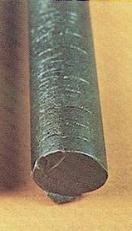
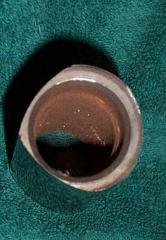
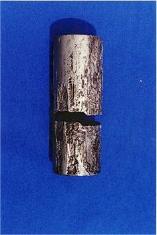
| . |
| . |
| . |
| . |
| . |
| . |
| . |


| Engineering: |
| Sales: |
| . |
| Downloadable version: Failure Analysis.pdf |


